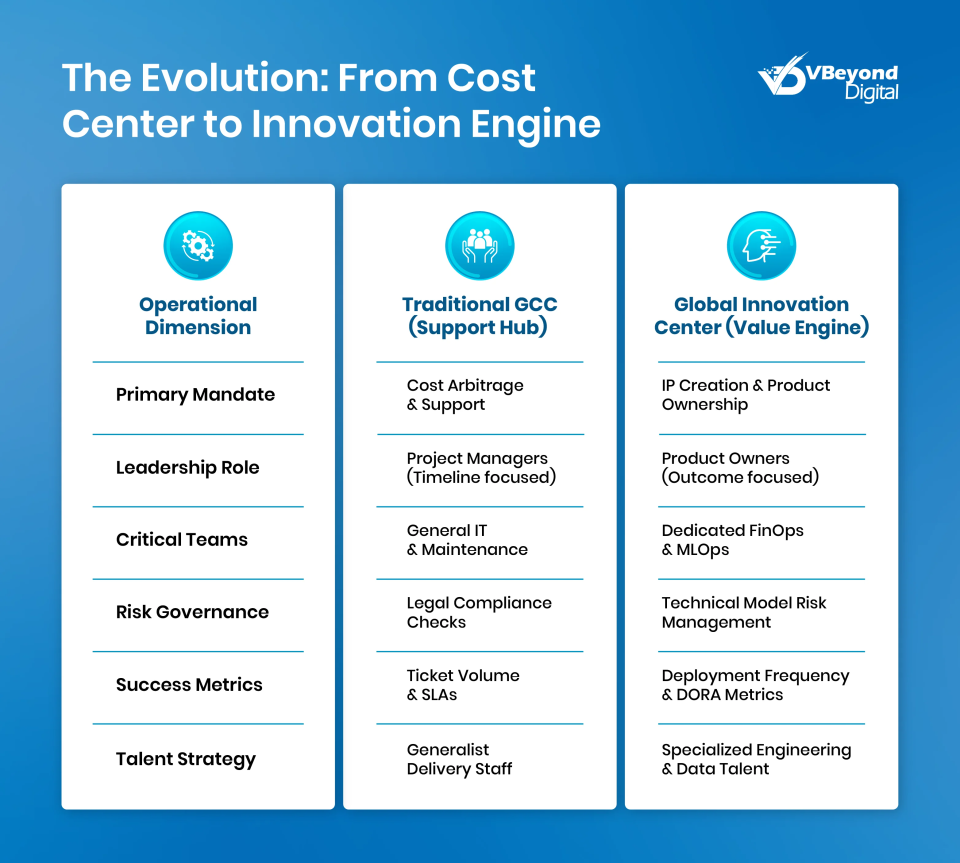The Future of Global Capability Centers: AI, ESG, and the Rise of the Global Innovation Center
Section
Table of Contents
- Enterprise pain points the model must address
- Outcome-first narrative: What the GCC-to-GIC shift enables
- The AI pillar: From pilots to scaled capability
- The ESG pillar: Disclosure that stands up to audit and investor scrutiny
- Operating model upgrades that make GCCs credible innovation engines
- Conclusion
- FAQs (Frequently Asked Question)
- Global Capability Centers are shifting from cost arbitrage to Global Innovation Centers to own products and intellectual property.
- Mandatory CSRD reporting and Generative AI priorities are the two primary catalysts driving this structural change.
- Operational models must upgrade to include dedicated MLOps, product ownership, and audit-ready data governance frameworks.
- Integrated platforms reduce risk by aligning AI safety protocols with the lineage requirements of sustainability disclosures.
The mandate for the Global Capability Center (GCC) is changing. For two decades, these hubs served primarily as cost-efficiency engines, centralizing back-office functions to capture labor arbitrage. That model has reached its limit. The modern enterprise now demands a center that generates intellectual property, owns product outcomes, and manages critical risk. This pressure is driving a structural migration from the traditional support hub to the Global Innovation Center (GIC).
This shift is not merely a branding exercise. It represents a fundamental change in how multinational corporations manage technology and compliance. CIOs and CTOs are no longer looking for service tickets to be closed cheaply; they are looking for platforms to be built securely. The Global Innovation Center stands as the answer to this demand, acting as the primary engine for complex engineering and regulatory data management.
Enterprise pain points the model must address
A traditional Global Capability Center often operates as a delivery silo. While efficient at executing defined tasks, it struggles to support the cross-functional demands of modern digital business. Leaders attempting to build new products or manage complex regulatory requirements frequently encounter structural friction, leading to operational failures that prevent the enterprise from realizing the full value of its technology investments.
The following pain points represent the primary obstacles that a legacy Global Capability Center setup fails to solve:
- Fragmented Data Lineage and Governance: Most enterprises suffer from data estates that are siloed by function. Financial data sits in one ERP, supply chain data in another system, and HR data in a third. Fragmentation blocks secure AI adoption because models cannot access a unified context without hallucinating or breaching security protocols. Similarly, disconnection makes CSRD reporting nearly impossible. When data lineage is broken, auditors cannot trace a sustainability metric back to its source, creating significant compliance risk.
- Integration and Interoperability Gaps: A common friction point within the GCC operating model is the inability to connect legacy ERP systems with modern data platforms and application suites. The lack of interoperability slows release cycles. Engineering teams spend more time building custom connectors and patching data pipelines than they do shipping features. Technical debt accumulates, preventing the center from responding to market changes promptly.
- Scalability Limits in Model Hosting and Inference: Many centers launch AI pilots successfully but fail to scale them. The infrastructure required for model hosting, feature sharing, and controlling inference costs is often missing from a standard IT support environment. Without dedicated GPU capacity planning and autoscaling thresholds, the cost of running Generative AI workloads becomes prohibitive, stalling projects before they reach production.
- Visibility Gaps Across the Value Chain: ESG Transformation requires deep visibility into the supply chain to calculate Scope 3 emissions. Legacy centers often lack the mandate or the technical integration to access supplier data. This creates a visibility gap that makes producing value chain metrics difficult. Without this data, the enterprise cannot meet the rigorous demands of CSRD reporting or ISSB standards, leaving the organization exposed to regulatory penalties.
- Talent and Accountability Misalignment: A traditional support model incentivizes activity rather than outcomes. Teams measure success by tickets closed or hours billed, rather than product performance. This creates a stall in the GCC to GIC shift. Product managers and engineers need to own the lifecycle of the solution, not just the delivery of code. When accountability is limited to delivery, the center cannot function as a true innovation partner.
Secure your data, scale AI.
Outcome-first narrative: What the GCC-to-GIC shift enables
Moving from a support-based structure to a Global Innovation Center changes the fundamental value equation of the site. The transition allows the enterprise to own its intellectual property and control its most critical data assets. The shift addresses the pain points listed above by reorganizing teams around products and platforms rather than functional tasks.
Implementing a robust Global Innovation Center strategy enables the following measurable business outcomes:
- Faster Product and Platform Delivery: By removing integration barriers and establishing clear platform ownership, the center can achieve a measurable release cadence. Service reliability improves because teams own the code they write in production. This operational maturity allows the business to push updates daily or weekly, rather than monthly, directly impacting competitive advantage.
- Secure GenAI at Scale: The new model provides the governance required to run AI safely. It establishes audit-ready telemetry and cost governance, allowing the enterprise to move from experimental pilots to scaled services. With a proper GCC operating model for AI, the organization can enforce safety filters and manage prompt libraries centrally, reducing Model risk management GCC concerns.
- Investor-Grade ESG Disclosures: A Global Innovation Center serves as the central hub for sustainability data. It unifies fragmented data sources to produce disclosures that align with CSRD reporting and ISSB mandates. This allows the enterprise to report traceable metrics and targets that stand up to external audit. The result is an ESG Transformation that satisfies investors and regulators alike.
- Accelerated Local Innovation Cycles: Bringing product ownership into the center shortens the window between idea and impact. In priority domains such as healthcare, retail, and BFSI, local teams can prototype, test, and release solutions without waiting for headquarters to dictate every step. This autonomy allows the center to solve specific regional or business-line problems with greater precision.
- Durable Engineering and Data Skills: The shift creates a hiring model that builds long-term capability. Top-tier engineers and data scientists prefer to work in environments where they own the product. By offering roles that focus on outcome ownership rather than ticket processing, the center attracts and retains high-value talent in priority hubs. This builds a durable knowledge base that strengthens the enterprise over time.
The AI pillar: From pilots to scaled capability
The experimental phase of Generative AI is ending. 2024 was a year of proof-of-concept work, but 2025 demanded production-grade stability. CIOs and CTOs now face the specific challenge of industrializing these models. A Global Capability Center is uniquely positioned to lead this industrialization because it houses the data, the engineering talent, and the governance structures under one roof.
Technical Building Blocks for Scale
Building a Global Innovation Center capable of supporting enterprise AI requires specific architectural decisions. These are not general IT upgrades. They are targeted investments in the AI lifecycle that allow teams to move fast without breaking security protocols.
- Reusable Retrieval and Safety Patterns: Isolating Large Language Models (LLMs) from enterprise data leads to hallucinations. To solve this, the Global Capability Center must implement Retrieval-Augmented Generation (RAG) patterns as a standard service. This involves setting up vector databases and semantic search capabilities that any product team can use.
- Feature Stores and Prompt Management: Ad hoc prompt engineering creates technical debt. A mature Global Capability Center implements centralized prompt management systems. These systems treat prompts as code, with version control, testing, and rollback capabilities. A shared feature store allows data scientists to reuse validated data features across different models, reducing the time required to build new training datasets.
- GPU and Inference Planning: Cloud costs for AI can spiral quickly without controls. The Global Capability Center must define capacity tiers and autoscaling thresholds. This involves establishing strict cost ceilings for inference units. By treating compute resources as a finite budget rather than an infinite utility, the center forces teams to write efficient code and choose the right model size for the task.
The AI Operating Model
Technology alone does not create a Global Innovation Center. The way teams work must change to accommodate the probabilistic nature of AI. Unlike traditional software, AI models can drift and behave unpredictably. The GCC operating model must adapt to manage this variance.
- Data Product Ownership: Data is no longer just a byproduct of applications; it is a product itself. The Global Capability Center needs dedicated data product owners who are accountable for the quality, freshness, and lineage of the data feeding AI models. These owners work directly with business units to define what “good” data looks like for specific use cases.
- Model Risk Management GCC: Risk governance for AI cannot be an afterthought. Model risk management GCC frameworks must be integrated into the delivery pipeline. This includes automated testing for bias and performance degradation. It also requires a “human-in-the-loop” review process for high-stakes decisions. The center must have clear protocols for who signs off on a model before it goes live and who is responsible if the model fails.
- Delivery Patterns for Stable Services: Converting a proof-of-concept into a stable service requires a shift in delivery standards. The Global Capability Center must mandate standard APIs and service level objectives (SLOs) for all AI applications. Rigor allows business units to integrate AI services into their daily workflows with confidence, knowing the system will be available and responsive when needed.

The ESG pillar: Disclosure that stands up to audit and investor scrutiny
Sustainability reporting has historically been a marketing function. It relied on estimates and manual spreadsheets. That period is over. The shift to regulated, audited non-financial reporting places the Global Capability Center at the center of corporate compliance. Finance and risk teams cannot produce the necessary data alone. They require the engineering capacity and data reach that only a Global Capability Center possesses.
What Changes in 2024 to 2025
The regulatory timeline creates immediate pressure for enterprise leaders. The Corporate Sustainability Reporting Directive (CSRD) requires the first cohort of companies to publish reports in 2025, covering financial periods beginning in 2024. This is a hard deadline mandated by the European Commission. It treats sustainability data with the same rigor as financial data.
Simultaneously, the International Sustainability Standards Board (ISSB) has established a global baseline with its S1 and S2 standards. These standards cover governance, strategy, risk management, metrics, and targets. They align closely with the Task Force on Climate-related Financial Disclosures (TCFD) recommendations. The convergence of these standards means that multinational organizations must produce consistent, high-quality data across all jurisdictions. A fragmented approach will fail. A unified Global Innovation Center approach provides the necessary cohesion.
What This Means for GCC Leaders
To meet these requirements, the GCC operating model must treat ESG data as a core asset. The center must build the infrastructure to support ESG Transformation across the enterprise.
- Data Controls and Entity Scoping: Auditors will test the boundary of the data. The Global Capability Center must design data platforms that clearly define which entities are included in the reporting scope. Value chain coverage must be explicit. If the data platform cannot distinguish between a wholly-owned subsidiary and a joint venture, the CSRD reporting will be inaccurate.
- Double Materiality Mapping: CSRD reporting requires a double materiality assessment. This involves analyzing how the business impacts the environment (impact materiality) and how the environment impacts the business (financial materiality). The Global Capability Center must codify this logic. Engineers need to map metrics directly to these materiality assessments. This creates a digital audit trail that explains why specific data points were collected and how they were calculated.
- Control Testing and Workflow Integration: The Global Capability Center must work with finance and risk teams to implement internal controls over sustainability reporting (ICSR). This involves automated testing of data pipelines to verify accuracy. Workflows must integrate with existing finance systems. When a sustainability metric is reported, it should flow through the same approval channels as a financial figure.
Example Data Products for ESG
A Global Innovation Center proves its value by building specific data products that solve these compliance challenges.
- Supplier Emissions Pipeline: Scope 3 emissions often constitute the majority of an organization’s carbon footprint. A Global Capability Center can build a pipeline that ingests supplier data, applies quality scoring, and calculates emissions based on spend or activity data. This product removes the reliance on rough industry averages and provides the granular data needed for ESG Transformation.
- Climate Scenario Inputs: Strategy teams need to model the financial impact of climate risks under different scenarios (e.g., 1.5°C vs. 4°C warming). The Global Capability Center can aggregate the necessary physical and transition risk data to feed these models. By providing high-quality inputs aligned to board-approved targets, the center enables the business to make defensible strategic decisions.
Operating model upgrades that make GCCs credible innovation engines
Structural changes must accompany technical upgrades. A Global Capability Center cannot deliver the results of a Global Innovation Center while using an outdated organizational chart. The hierarchy must flatten. The focus must shift from managing headcount to managing products. This requires a specific set of upgrades to the GCC operating model that prioritizes accountability and speed.
Roles and Accountability
Contracts and regulations set the playing field for Cloud cost management and Cloud exit strategy. Your teams need a precise view of what is possible, by when, and under which conditions.
The most critical shift is the move from project management to product ownership. In a traditional Global Capability Center, managers oversee timelines and budgets for projects defined elsewhere. In a Global Innovation Center, Product Owners sit within the center. They hold full authority over the roadmap, the backlog, and the user experience.
Platform ownership is equally important. Dedicated leaders must own the internal developer platforms that serve the wider enterprise. These owners are responsible for the stability and utility of the tools that other teams use.
Model risk management GCC functions must also be formalized. This role is no longer a side desk for a legal compliance officer. It requires technical leaders who understand AI architecture. These owners define the acceptable risk levels for AI deployments and have the authority to halt releases that violate safety protocols or data governance rules.
First-Class Teams: FinOps and MLOps
Operational disciplines that were once optional are now mandatory. FinOps and MLOps must exist as first-class teams within the Global Capability Center.
FinOps teams are responsible for the unit economics of the cloud. They do not just report on costs; they actively engineer cost reductions. They work with engineering teams to select the right instance types and manage reserved capacity.
MLOps teams manage the lifecycle of machine learning models. They build the pipelines that automate retraining and deployment. Without a dedicated MLOps function, the GCC to GIC shift will stall because data scientists will remain trapped in manual deployment cycles, unable to scale their work.
Metrics That Matter
The metrics used to evaluate a Global Capability Center must change to reflect this new reality. Service Level Agreements (SLAs) based on ticket response times are insufficient. The enterprise must track DevOps Research and Assessment (DORA) metrics to measure engineering efficiency:
- Deployment Frequency: How often is code successfully released to production?
- Change Failure Rate: What percentage of changes result in degraded service?
- Mean Time to Restore (MTTR): How quickly can the team recover from a failure?
Talent and Hiring Signals
The talent strategy must align with these operational changes. Hiring outlooks indicate that the expansion of centers will continue through the middle of the decade. Bengaluru and Hyderabad remain the leading hubs for this growth. However, the profiles being hired are changing. The demand is shifting away from generalist support roles toward specialized engineering and product talent. A Global Capability Center that fails to adjust its hiring criteria to target these specialized profiles will struggle to execute the GCC to GIC shift.
Conclusion
The evolution of the Global Capability Center is no longer a theoretical discussion. It is an operational necessity. The transition from a cost-based support hub to a value-driven Global Innovation Center is the only way to meet the dual demands of rapid AI industrialization and mandatory ESG Transformation.
The GCC to GIC shift requires more than just intent. It demands a structured plan for data, engineering, and reporting. VBeyond Digital helps technology leaders move from strategy to measurable outcomes. We provide the technical expertise and the operational blueprints necessary to build a credible Global Innovation Center. Whether you are establishing a new hub or upgrading an existing one, VBeyond Digital partners with you to build the products, platforms, and disclosures that define the modern enterprise.
Turn your Global Capability Center into an innovation engine today.
FAQs (Frequently Asked Question)
Historically, a GCC is a centralized hub designed as a cost-efficiency engine. Its primary function was to centralize back-office tasks and support functions to capture labor arbitrage for multinational enterprises.
A traditional GCC focuses on cost reduction and support tickets. A GIC focuses on value creation, generating intellectual property, owning product outcomes, and managing critical data risks like AI governance and ESG compliance.
The shift is driven by the need to industrialize Generative AI beyond pilots, meet mandatory ESG reporting deadlines (CSRD), utilize government R&D incentives, and move from a delivery silo to a product-led growth engine.
A GCC unifies fragmented data across business units to ensure lineage and traceability. It builds the platforms for double materiality mapping and automated control testing, producing the “investor-grade” disclosures required for audit.
Centers must shift from project management to true product ownership. They need to establish dedicated FinOps and MLOps teams and adopt engineering metrics like deployment frequency and change failure rates instead of simple volume SLAs.



